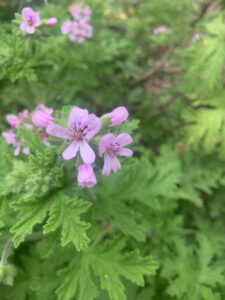
Why does my geranium smell?
By Clive Larkman
There are thousands and thousands of plants in the world, growing in almost every climatic zone. They have a wide range of forms and shapes, and includes flowering and non-flowering plants. The flower colours are diverse and cover most common shades. The characteristic that amazes me the most, is the range of aromas that come from plants. Not just the fragrance from the flowers but smells that come from the essential oils extracted from all different plant parts. There is an essential oil generated from every part of plants. Each plant is different and some have oils in their bark, some in their flowers, some in the foliage and so-on.
These smells come through the essential oils which can be specific to a single plant or blended through a range of related and unrelated plants. The whole subject is exceedingly diverse and the number of oils is almost infinite. Each plant has its own range that gives it a particular scent. Sometimes it is a very strong and defined scent like ‘lemon’ that comes from a few chemicals, or sometimes it is more complex and consists of multiple chemicals.
The real mind-blower is the range of unrelated plants that have a similar fragrance. It is here that the group of plants known as Scented Geraniums come to the top. Most of them are horticultural hybrids but there are some species with their own particular scent. These all have medium to large foliage with very strong aromas and are popular in making teas and used in aromatherapy. The fragrances vary greatly, from Rose Scented (Pelargonium graveolens) to Lemon Scented (Pelargonium crispum) with everything in between including cinnamon, nutmeg and apple cider. There is even a rare fragrance in plants that is reminiscent of coconut. This species is P. grossularioides and along with P. x fragrans is similar in appearance to some of the small grey leaved geraniums.
Many of these plants are drought hardy and will grow in very dry light shade, e.g., under pine trees. They are happy in full to part sun with moist to dry soils. They particularly do not like heavy (clay) and wet soils and many are not frost tolerant. The plants have been grown by keen gardeners for hundreds of years and due to the strong scents, they have attained some prominence in traditional medicine over the centuries.
Most have an interesting fragrance and attractive form and habit but the flowers, though pretty, are not a stand-out item. The structure is consistent and definitive for all plants of the genus. The colours are generally white, pink or pale red, and usually small but with lots of flowers per bush in loose umbels. The foliage is nearly always grey or grey-green with a selection of variegated forms. The leaves are always lobed, divided or palmate and never simple. It is in the foliage that the essential oils occur and thus the fragrance. The plants will grow in most Australian gardens and are best planted where they can be brushed against or the foliage picked and crushed.
As I said above the fragrances are quite varied and the only way to explain this is to list some of the main ones:
Nutmeg and Coconut Geraniums are two classics with Pelargonium fragrans having a strong nutmeg fragrance and Pelargonium grossularioides having a pungent coconut fragrance. Both have small, lobed, grey foliage and dainty white flowers.
Pelargonium tomentosum has the most powerful peppermint fragrance. It has large velvet-like, grey-green foliage and small white flowers. It likes a dry and sunny situation but will tolerate light shade as long as the soil is well drained.
Pelargonium graveolens is one of the most widely known and grown of the scented geraniums. It originally came from South Africa but is very rare in the wild and it is believed that the modern forms are selected cultivars of the wild plant. It is a tough and large plant with woody stems and large divided foliage with an extremely strong, rose-like fragrance. It is distilled to produce a strong, rose-like essential oil.
Pelargonium crispum looks quite different to the other species with a narrow upright habit and small, crinkled foliage. Like the other varieties, it has a strong aroma that is reminiscent of lemons, the very same aroma that comes from other lemon-scented plants like Aloysia triphylla, Melissa officinalis and Lemongrass.
Other fragrances include Old Spice, Orange Peel, Lime, Tutti Frutti, Cinnamon, Citronella, Apple Cider, Apricot and the weird Pine. All of these can be used in salads, teas, soft drinks and desserts.
Main photo: Pelargonium citrosum is claimed to repel mosquitos (Image: Karen Smith)
